Victoria University Taxation Law Principles Assignment Report
VerifiedAdded on 2020/02/24
|10
|2405
|70
Report
AI Summary
This report analyzes two case studies related to Australian taxation law. Part A examines the tax implications for Robyn Rainer, a lecturer working in Calcutta under the Victoria University, considering her assessable income, deductions (rent and mortgage), and residency status, and the application of foreign income tax offset. Part B focuses on Mr. Paul, a golf instructor, and assesses his assessable income from lessons (single and series), and an appreciation gift, and calculates his taxable income after deductions for expenses. The report applies the Income Tax Assessment Act 1997, considering deductions, and Medicare levy. The report also provides a comprehensive overview of the relevant tax principles and calculations, demonstrating an understanding of Australian taxation laws.
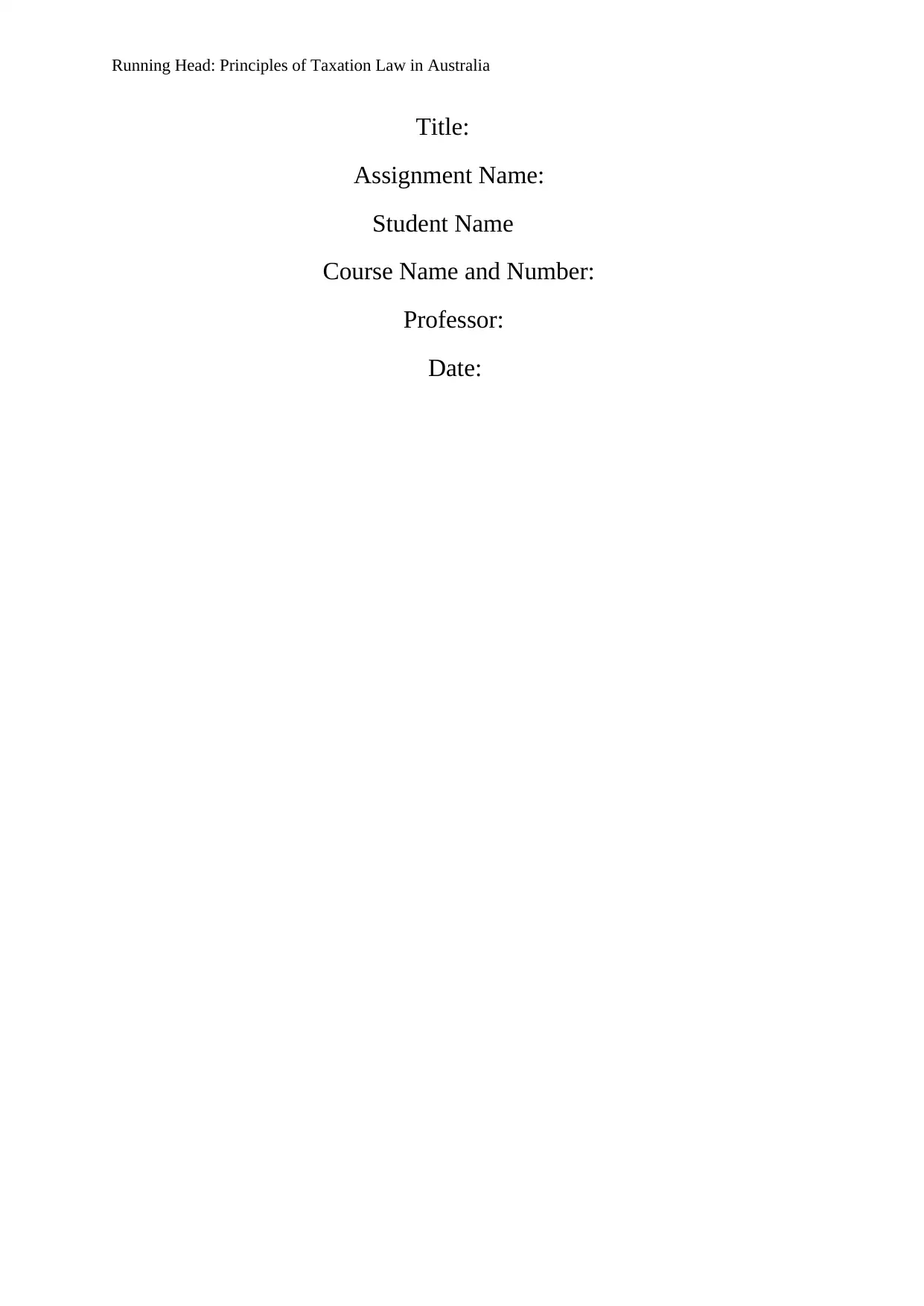
Running Head: Principles of Taxation Law in Australia
Title:
Assignment Name:
Student Name
Course Name and Number:
Professor:
Date:
Title:
Assignment Name:
Student Name
Course Name and Number:
Professor:
Date:
Paraphrase This Document
Need a fresh take? Get an instant paraphrase of this document with our AI Paraphraser
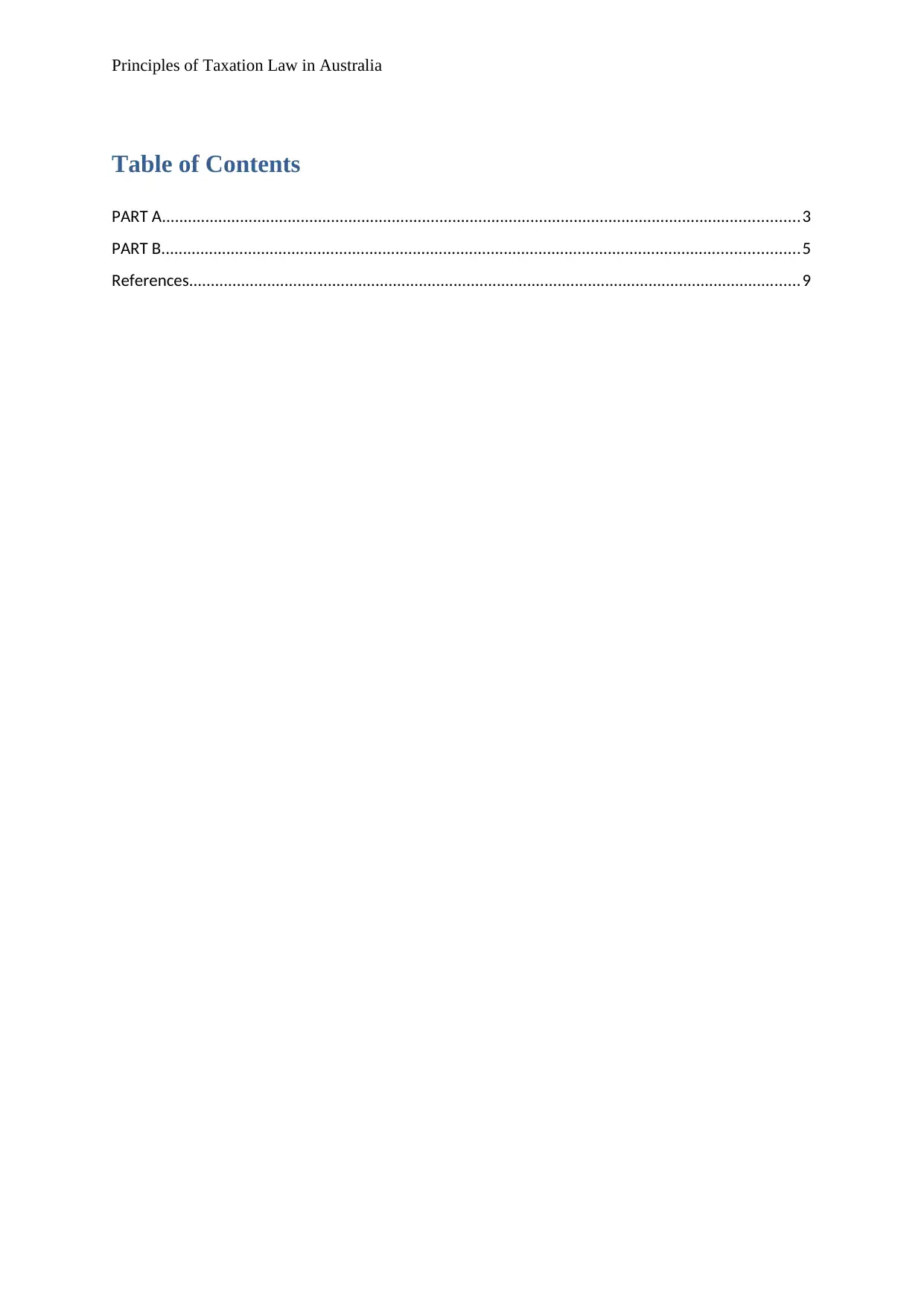
Principles of Taxation Law in Australia
Table of Contents
PART A...................................................................................................................................................3
PART B...................................................................................................................................................5
References.............................................................................................................................................9
Table of Contents
PART A...................................................................................................................................................3
PART B...................................................................................................................................................5
References.............................................................................................................................................9
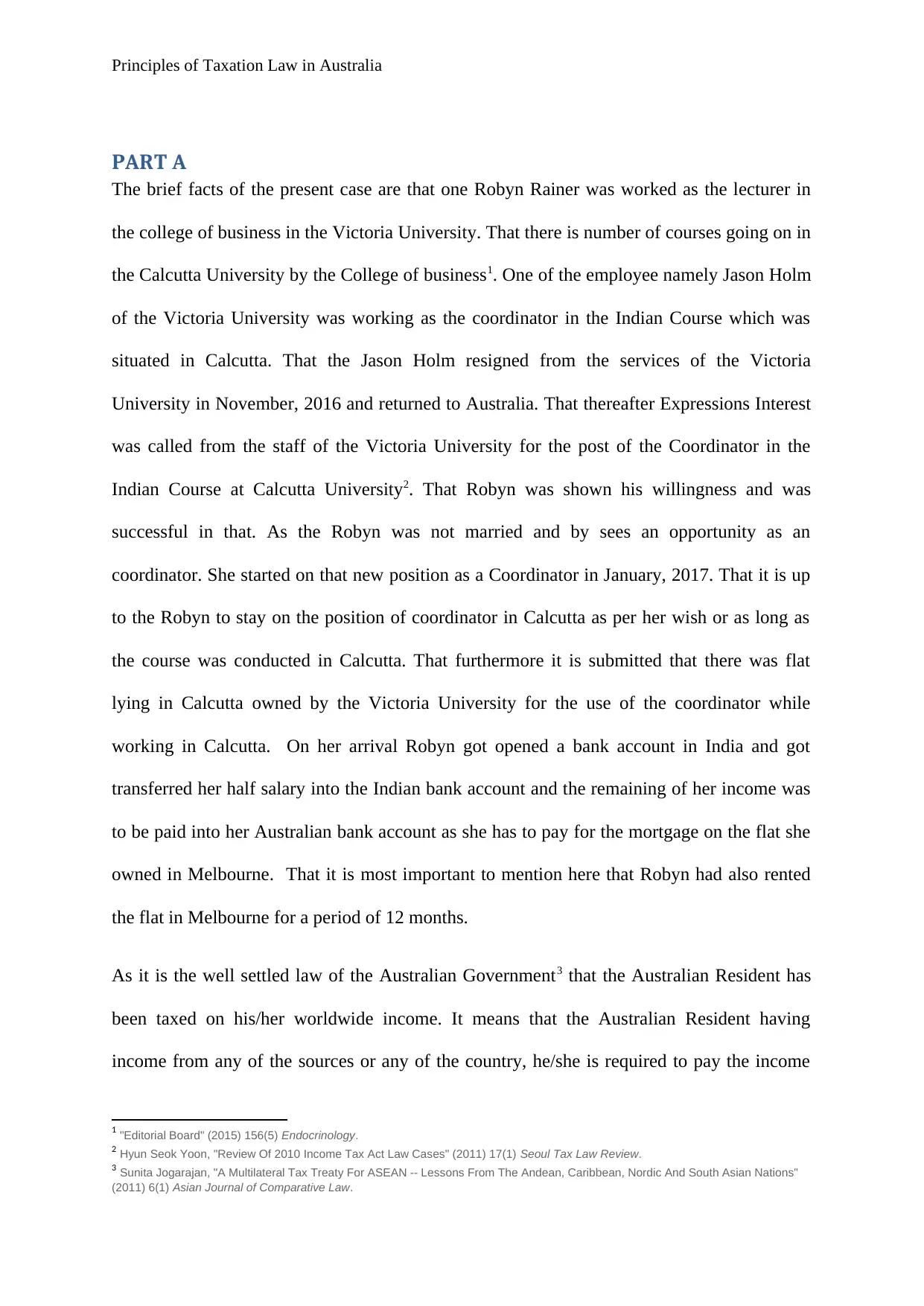
Principles of Taxation Law in Australia
PART A
The brief facts of the present case are that one Robyn Rainer was worked as the lecturer in
the college of business in the Victoria University. That there is number of courses going on in
the Calcutta University by the College of business1. One of the employee namely Jason Holm
of the Victoria University was working as the coordinator in the Indian Course which was
situated in Calcutta. That the Jason Holm resigned from the services of the Victoria
University in November, 2016 and returned to Australia. That thereafter Expressions Interest
was called from the staff of the Victoria University for the post of the Coordinator in the
Indian Course at Calcutta University2. That Robyn was shown his willingness and was
successful in that. As the Robyn was not married and by sees an opportunity as an
coordinator. She started on that new position as a Coordinator in January, 2017. That it is up
to the Robyn to stay on the position of coordinator in Calcutta as per her wish or as long as
the course was conducted in Calcutta. That furthermore it is submitted that there was flat
lying in Calcutta owned by the Victoria University for the use of the coordinator while
working in Calcutta. On her arrival Robyn got opened a bank account in India and got
transferred her half salary into the Indian bank account and the remaining of her income was
to be paid into her Australian bank account as she has to pay for the mortgage on the flat she
owned in Melbourne. That it is most important to mention here that Robyn had also rented
the flat in Melbourne for a period of 12 months.
As it is the well settled law of the Australian Government3 that the Australian Resident has
been taxed on his/her worldwide income. It means that the Australian Resident having
income from any of the sources or any of the country, he/she is required to pay the income
1 "Editorial Board" (2015) 156(5) Endocrinology.
2 Hyun Seok Yoon, "Review Of 2010 Income Tax Act Law Cases" (2011) 17(1) Seoul Tax Law Review.
3 Sunita Jogarajan, "A Multilateral Tax Treaty For ASEAN -- Lessons From The Andean, Caribbean, Nordic And South Asian Nations"
(2011) 6(1) Asian Journal of Comparative Law.
PART A
The brief facts of the present case are that one Robyn Rainer was worked as the lecturer in
the college of business in the Victoria University. That there is number of courses going on in
the Calcutta University by the College of business1. One of the employee namely Jason Holm
of the Victoria University was working as the coordinator in the Indian Course which was
situated in Calcutta. That the Jason Holm resigned from the services of the Victoria
University in November, 2016 and returned to Australia. That thereafter Expressions Interest
was called from the staff of the Victoria University for the post of the Coordinator in the
Indian Course at Calcutta University2. That Robyn was shown his willingness and was
successful in that. As the Robyn was not married and by sees an opportunity as an
coordinator. She started on that new position as a Coordinator in January, 2017. That it is up
to the Robyn to stay on the position of coordinator in Calcutta as per her wish or as long as
the course was conducted in Calcutta. That furthermore it is submitted that there was flat
lying in Calcutta owned by the Victoria University for the use of the coordinator while
working in Calcutta. On her arrival Robyn got opened a bank account in India and got
transferred her half salary into the Indian bank account and the remaining of her income was
to be paid into her Australian bank account as she has to pay for the mortgage on the flat she
owned in Melbourne. That it is most important to mention here that Robyn had also rented
the flat in Melbourne for a period of 12 months.
As it is the well settled law of the Australian Government3 that the Australian Resident has
been taxed on his/her worldwide income. It means that the Australian Resident having
income from any of the sources or any of the country, he/she is required to pay the income
1 "Editorial Board" (2015) 156(5) Endocrinology.
2 Hyun Seok Yoon, "Review Of 2010 Income Tax Act Law Cases" (2011) 17(1) Seoul Tax Law Review.
3 Sunita Jogarajan, "A Multilateral Tax Treaty For ASEAN -- Lessons From The Andean, Caribbean, Nordic And South Asian Nations"
(2011) 6(1) Asian Journal of Comparative Law.
⊘ This is a preview!⊘
Do you want full access?
Subscribe today to unlock all pages.

Trusted by 1+ million students worldwide
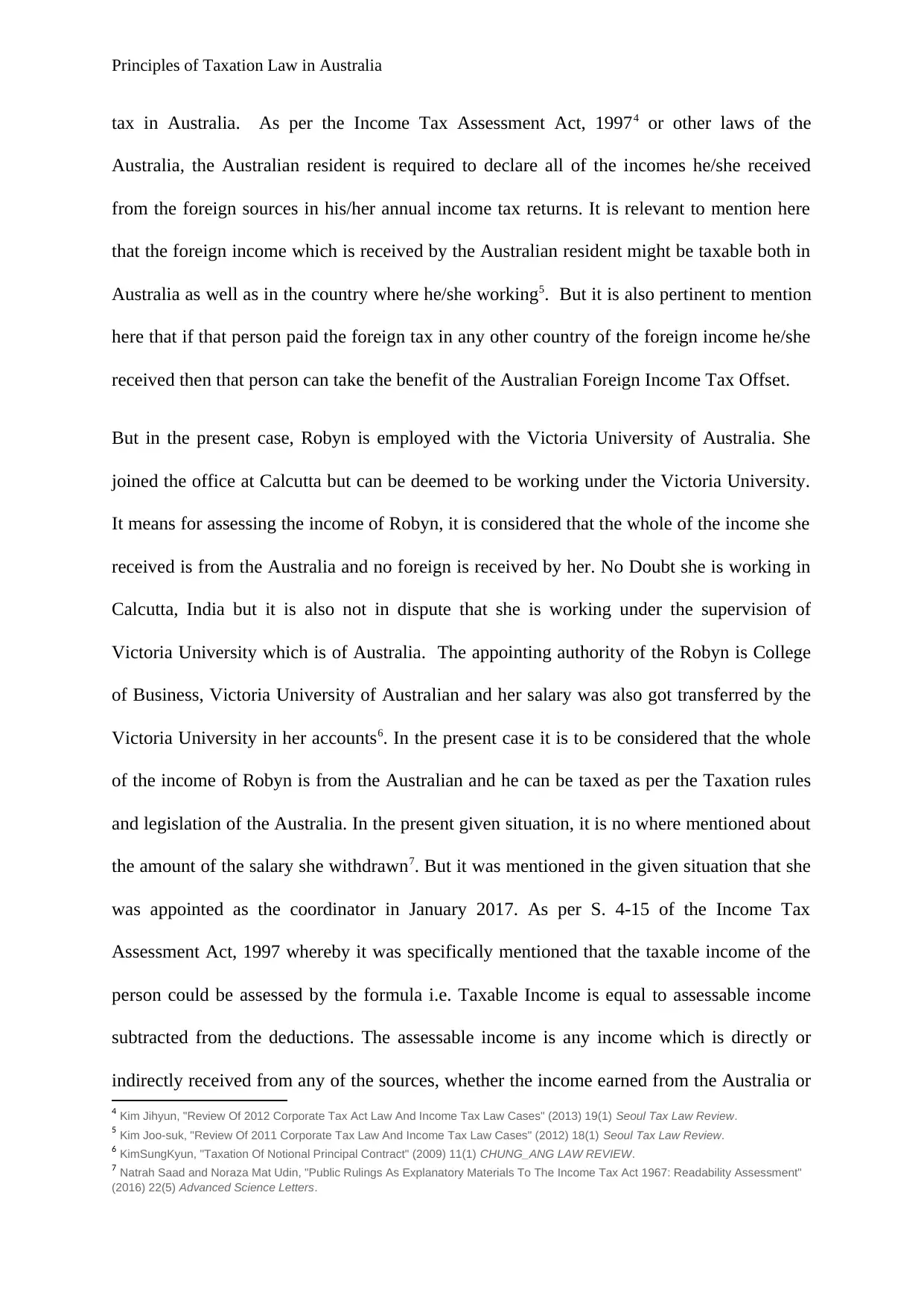
Principles of Taxation Law in Australia
tax in Australia. As per the Income Tax Assessment Act, 19974 or other laws of the
Australia, the Australian resident is required to declare all of the incomes he/she received
from the foreign sources in his/her annual income tax returns. It is relevant to mention here
that the foreign income which is received by the Australian resident might be taxable both in
Australia as well as in the country where he/she working5. But it is also pertinent to mention
here that if that person paid the foreign tax in any other country of the foreign income he/she
received then that person can take the benefit of the Australian Foreign Income Tax Offset.
But in the present case, Robyn is employed with the Victoria University of Australia. She
joined the office at Calcutta but can be deemed to be working under the Victoria University.
It means for assessing the income of Robyn, it is considered that the whole of the income she
received is from the Australia and no foreign is received by her. No Doubt she is working in
Calcutta, India but it is also not in dispute that she is working under the supervision of
Victoria University which is of Australia. The appointing authority of the Robyn is College
of Business, Victoria University of Australian and her salary was also got transferred by the
Victoria University in her accounts6. In the present case it is to be considered that the whole
of the income of Robyn is from the Australian and he can be taxed as per the Taxation rules
and legislation of the Australia. In the present given situation, it is no where mentioned about
the amount of the salary she withdrawn7. But it was mentioned in the given situation that she
was appointed as the coordinator in January 2017. As per S. 4-15 of the Income Tax
Assessment Act, 1997 whereby it was specifically mentioned that the taxable income of the
person could be assessed by the formula i.e. Taxable Income is equal to assessable income
subtracted from the deductions. The assessable income is any income which is directly or
indirectly received from any of the sources, whether the income earned from the Australia or
4 Kim Jihyun, "Review Of 2012 Corporate Tax Act Law And Income Tax Law Cases" (2013) 19(1) Seoul Tax Law Review.
5 Kim Joo-suk, "Review Of 2011 Corporate Tax Law And Income Tax Law Cases" (2012) 18(1) Seoul Tax Law Review.
6 KimSungKyun, "Taxation Of Notional Principal Contract" (2009) 11(1) CHUNG_ANG LAW REVIEW.
7 Natrah Saad and Noraza Mat Udin, "Public Rulings As Explanatory Materials To The Income Tax Act 1967: Readability Assessment"
(2016) 22(5) Advanced Science Letters.
tax in Australia. As per the Income Tax Assessment Act, 19974 or other laws of the
Australia, the Australian resident is required to declare all of the incomes he/she received
from the foreign sources in his/her annual income tax returns. It is relevant to mention here
that the foreign income which is received by the Australian resident might be taxable both in
Australia as well as in the country where he/she working5. But it is also pertinent to mention
here that if that person paid the foreign tax in any other country of the foreign income he/she
received then that person can take the benefit of the Australian Foreign Income Tax Offset.
But in the present case, Robyn is employed with the Victoria University of Australia. She
joined the office at Calcutta but can be deemed to be working under the Victoria University.
It means for assessing the income of Robyn, it is considered that the whole of the income she
received is from the Australia and no foreign is received by her. No Doubt she is working in
Calcutta, India but it is also not in dispute that she is working under the supervision of
Victoria University which is of Australia. The appointing authority of the Robyn is College
of Business, Victoria University of Australian and her salary was also got transferred by the
Victoria University in her accounts6. In the present case it is to be considered that the whole
of the income of Robyn is from the Australian and he can be taxed as per the Taxation rules
and legislation of the Australia. In the present given situation, it is no where mentioned about
the amount of the salary she withdrawn7. But it was mentioned in the given situation that she
was appointed as the coordinator in January 2017. As per S. 4-15 of the Income Tax
Assessment Act, 1997 whereby it was specifically mentioned that the taxable income of the
person could be assessed by the formula i.e. Taxable Income is equal to assessable income
subtracted from the deductions. The assessable income is any income which is directly or
indirectly received from any of the sources, whether the income earned from the Australia or
4 Kim Jihyun, "Review Of 2012 Corporate Tax Act Law And Income Tax Law Cases" (2013) 19(1) Seoul Tax Law Review.
5 Kim Joo-suk, "Review Of 2011 Corporate Tax Law And Income Tax Law Cases" (2012) 18(1) Seoul Tax Law Review.
6 KimSungKyun, "Taxation Of Notional Principal Contract" (2009) 11(1) CHUNG_ANG LAW REVIEW.
7 Natrah Saad and Noraza Mat Udin, "Public Rulings As Explanatory Materials To The Income Tax Act 1967: Readability Assessment"
(2016) 22(5) Advanced Science Letters.
Paraphrase This Document
Need a fresh take? Get an instant paraphrase of this document with our AI Paraphraser
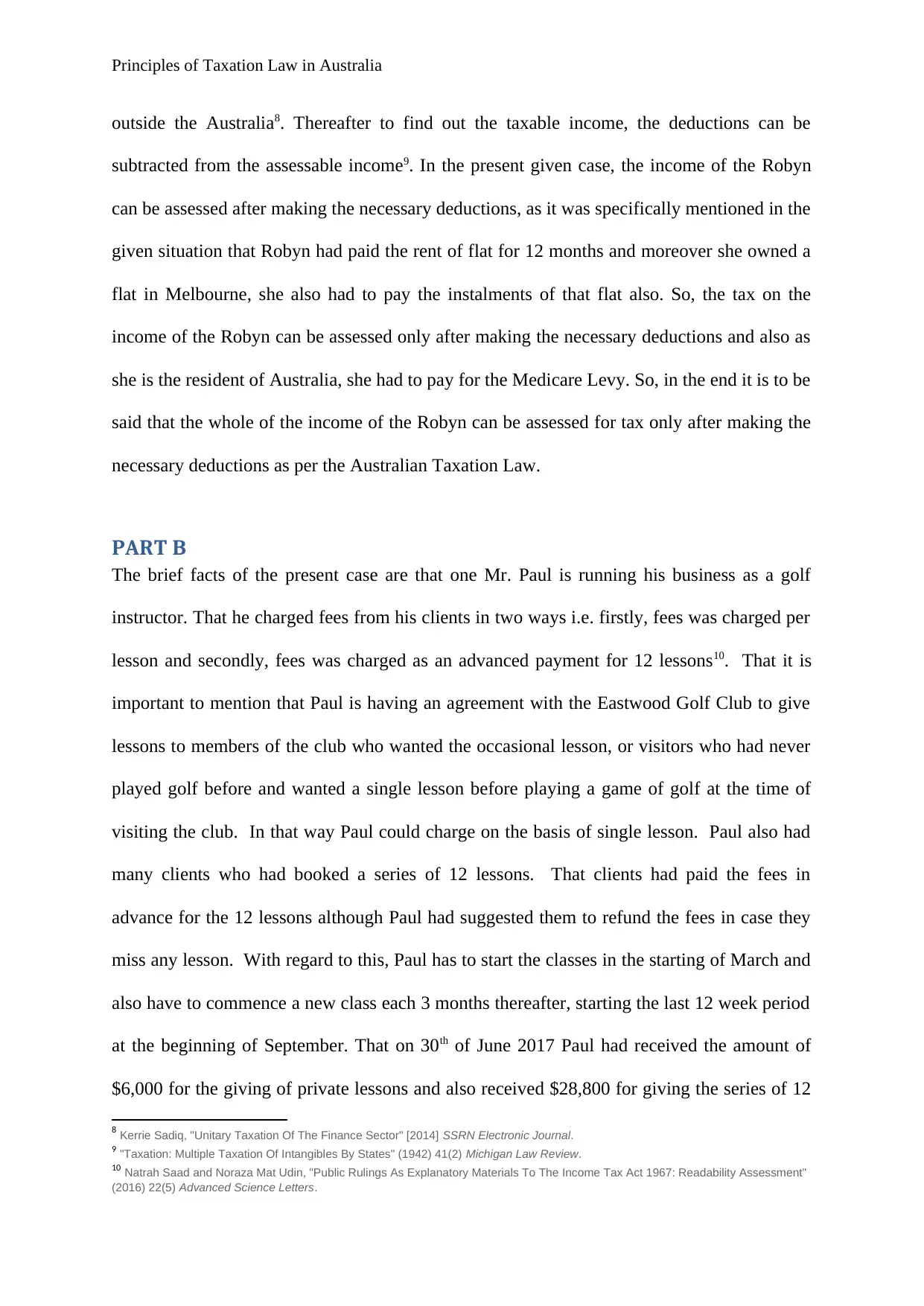
Principles of Taxation Law in Australia
outside the Australia8. Thereafter to find out the taxable income, the deductions can be
subtracted from the assessable income9. In the present given case, the income of the Robyn
can be assessed after making the necessary deductions, as it was specifically mentioned in the
given situation that Robyn had paid the rent of flat for 12 months and moreover she owned a
flat in Melbourne, she also had to pay the instalments of that flat also. So, the tax on the
income of the Robyn can be assessed only after making the necessary deductions and also as
she is the resident of Australia, she had to pay for the Medicare Levy. So, in the end it is to be
said that the whole of the income of the Robyn can be assessed for tax only after making the
necessary deductions as per the Australian Taxation Law.
PART B
The brief facts of the present case are that one Mr. Paul is running his business as a golf
instructor. That he charged fees from his clients in two ways i.e. firstly, fees was charged per
lesson and secondly, fees was charged as an advanced payment for 12 lessons10. That it is
important to mention that Paul is having an agreement with the Eastwood Golf Club to give
lessons to members of the club who wanted the occasional lesson, or visitors who had never
played golf before and wanted a single lesson before playing a game of golf at the time of
visiting the club. In that way Paul could charge on the basis of single lesson. Paul also had
many clients who had booked a series of 12 lessons. That clients had paid the fees in
advance for the 12 lessons although Paul had suggested them to refund the fees in case they
miss any lesson. With regard to this, Paul has to start the classes in the starting of March and
also have to commence a new class each 3 months thereafter, starting the last 12 week period
at the beginning of September. That on 30th of June 2017 Paul had received the amount of
$6,000 for the giving of private lessons and also received $28,800 for giving the series of 12
8 Kerrie Sadiq, "Unitary Taxation Of The Finance Sector" [2014] SSRN Electronic Journal.
9 "Taxation: Multiple Taxation Of Intangibles By States" (1942) 41(2) Michigan Law Review.
10 Natrah Saad and Noraza Mat Udin, "Public Rulings As Explanatory Materials To The Income Tax Act 1967: Readability Assessment"
(2016) 22(5) Advanced Science Letters.
outside the Australia8. Thereafter to find out the taxable income, the deductions can be
subtracted from the assessable income9. In the present given case, the income of the Robyn
can be assessed after making the necessary deductions, as it was specifically mentioned in the
given situation that Robyn had paid the rent of flat for 12 months and moreover she owned a
flat in Melbourne, she also had to pay the instalments of that flat also. So, the tax on the
income of the Robyn can be assessed only after making the necessary deductions and also as
she is the resident of Australia, she had to pay for the Medicare Levy. So, in the end it is to be
said that the whole of the income of the Robyn can be assessed for tax only after making the
necessary deductions as per the Australian Taxation Law.
PART B
The brief facts of the present case are that one Mr. Paul is running his business as a golf
instructor. That he charged fees from his clients in two ways i.e. firstly, fees was charged per
lesson and secondly, fees was charged as an advanced payment for 12 lessons10. That it is
important to mention that Paul is having an agreement with the Eastwood Golf Club to give
lessons to members of the club who wanted the occasional lesson, or visitors who had never
played golf before and wanted a single lesson before playing a game of golf at the time of
visiting the club. In that way Paul could charge on the basis of single lesson. Paul also had
many clients who had booked a series of 12 lessons. That clients had paid the fees in
advance for the 12 lessons although Paul had suggested them to refund the fees in case they
miss any lesson. With regard to this, Paul has to start the classes in the starting of March and
also have to commence a new class each 3 months thereafter, starting the last 12 week period
at the beginning of September. That on 30th of June 2017 Paul had received the amount of
$6,000 for the giving of private lessons and also received $28,800 for giving the series of 12
8 Kerrie Sadiq, "Unitary Taxation Of The Finance Sector" [2014] SSRN Electronic Journal.
9 "Taxation: Multiple Taxation Of Intangibles By States" (1942) 41(2) Michigan Law Review.
10 Natrah Saad and Noraza Mat Udin, "Public Rulings As Explanatory Materials To The Income Tax Act 1967: Readability Assessment"
(2016) 22(5) Advanced Science Letters.
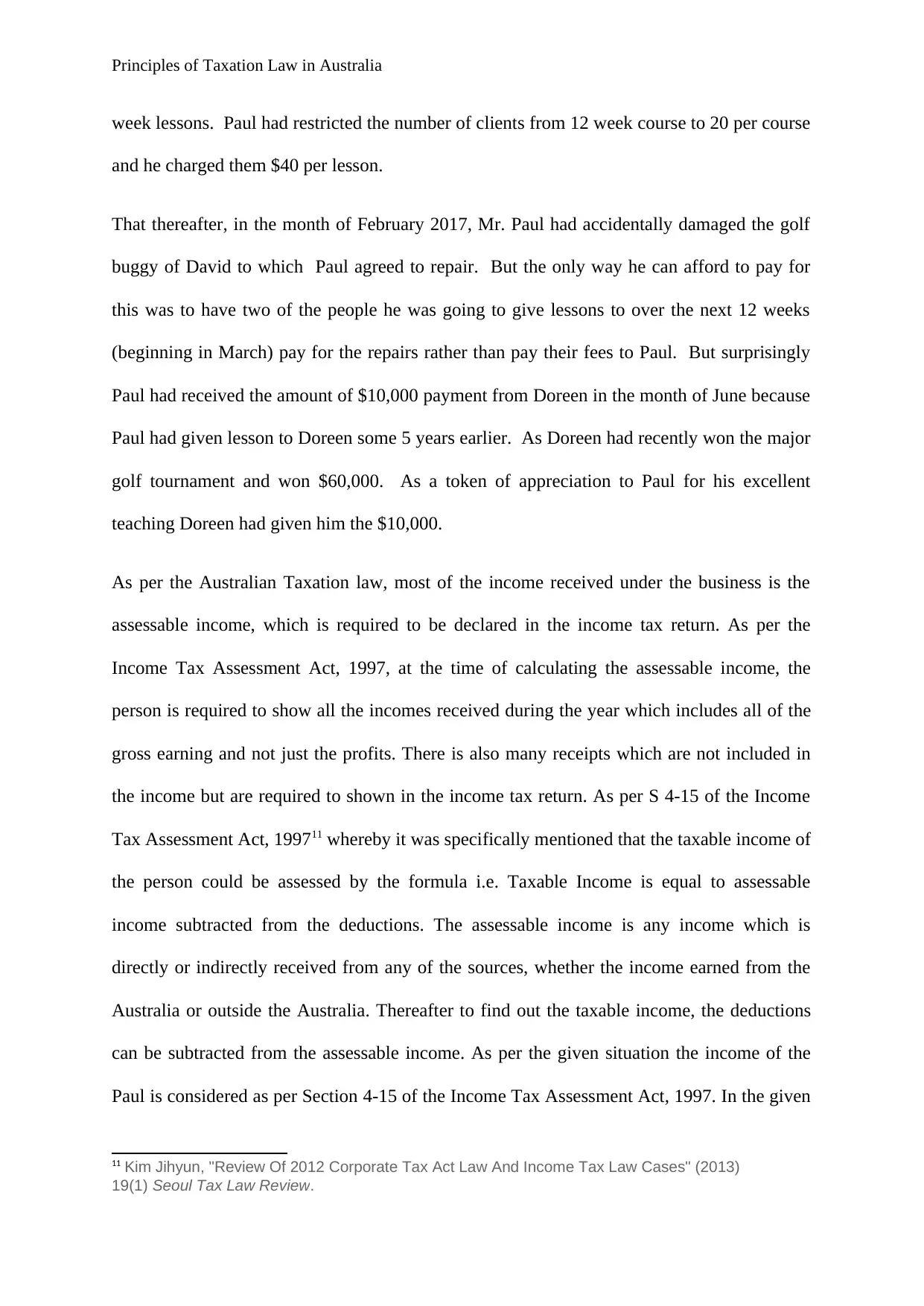
Principles of Taxation Law in Australia
week lessons. Paul had restricted the number of clients from 12 week course to 20 per course
and he charged them $40 per lesson.
That thereafter, in the month of February 2017, Mr. Paul had accidentally damaged the golf
buggy of David to which Paul agreed to repair. But the only way he can afford to pay for
this was to have two of the people he was going to give lessons to over the next 12 weeks
(beginning in March) pay for the repairs rather than pay their fees to Paul. But surprisingly
Paul had received the amount of $10,000 payment from Doreen in the month of June because
Paul had given lesson to Doreen some 5 years earlier. As Doreen had recently won the major
golf tournament and won $60,000. As a token of appreciation to Paul for his excellent
teaching Doreen had given him the $10,000.
As per the Australian Taxation law, most of the income received under the business is the
assessable income, which is required to be declared in the income tax return. As per the
Income Tax Assessment Act, 1997, at the time of calculating the assessable income, the
person is required to show all the incomes received during the year which includes all of the
gross earning and not just the profits. There is also many receipts which are not included in
the income but are required to shown in the income tax return. As per S 4-15 of the Income
Tax Assessment Act, 199711 whereby it was specifically mentioned that the taxable income of
the person could be assessed by the formula i.e. Taxable Income is equal to assessable
income subtracted from the deductions. The assessable income is any income which is
directly or indirectly received from any of the sources, whether the income earned from the
Australia or outside the Australia. Thereafter to find out the taxable income, the deductions
can be subtracted from the assessable income. As per the given situation the income of the
Paul is considered as per Section 4-15 of the Income Tax Assessment Act, 1997. In the given
11 Kim Jihyun, "Review Of 2012 Corporate Tax Act Law And Income Tax Law Cases" (2013)
19(1) Seoul Tax Law Review.
week lessons. Paul had restricted the number of clients from 12 week course to 20 per course
and he charged them $40 per lesson.
That thereafter, in the month of February 2017, Mr. Paul had accidentally damaged the golf
buggy of David to which Paul agreed to repair. But the only way he can afford to pay for
this was to have two of the people he was going to give lessons to over the next 12 weeks
(beginning in March) pay for the repairs rather than pay their fees to Paul. But surprisingly
Paul had received the amount of $10,000 payment from Doreen in the month of June because
Paul had given lesson to Doreen some 5 years earlier. As Doreen had recently won the major
golf tournament and won $60,000. As a token of appreciation to Paul for his excellent
teaching Doreen had given him the $10,000.
As per the Australian Taxation law, most of the income received under the business is the
assessable income, which is required to be declared in the income tax return. As per the
Income Tax Assessment Act, 1997, at the time of calculating the assessable income, the
person is required to show all the incomes received during the year which includes all of the
gross earning and not just the profits. There is also many receipts which are not included in
the income but are required to shown in the income tax return. As per S 4-15 of the Income
Tax Assessment Act, 199711 whereby it was specifically mentioned that the taxable income of
the person could be assessed by the formula i.e. Taxable Income is equal to assessable
income subtracted from the deductions. The assessable income is any income which is
directly or indirectly received from any of the sources, whether the income earned from the
Australia or outside the Australia. Thereafter to find out the taxable income, the deductions
can be subtracted from the assessable income. As per the given situation the income of the
Paul is considered as per Section 4-15 of the Income Tax Assessment Act, 1997. In the given
11 Kim Jihyun, "Review Of 2012 Corporate Tax Act Law And Income Tax Law Cases" (2013)
19(1) Seoul Tax Law Review.
⊘ This is a preview!⊘
Do you want full access?
Subscribe today to unlock all pages.

Trusted by 1+ million students worldwide
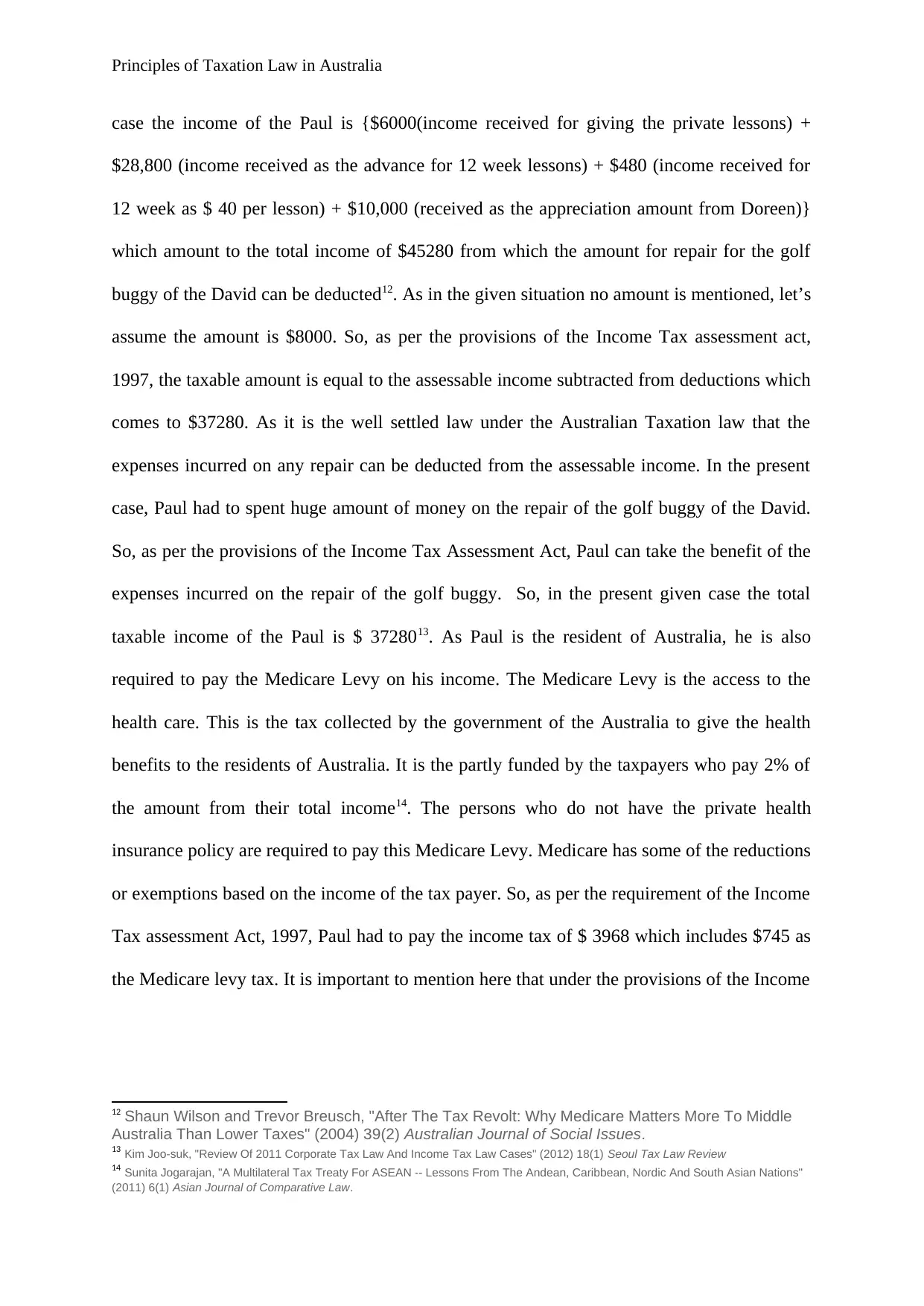
Principles of Taxation Law in Australia
case the income of the Paul is {$6000(income received for giving the private lessons) +
$28,800 (income received as the advance for 12 week lessons) + $480 (income received for
12 week as $ 40 per lesson) + $10,000 (received as the appreciation amount from Doreen)}
which amount to the total income of $45280 from which the amount for repair for the golf
buggy of the David can be deducted12. As in the given situation no amount is mentioned, let’s
assume the amount is $8000. So, as per the provisions of the Income Tax assessment act,
1997, the taxable amount is equal to the assessable income subtracted from deductions which
comes to $37280. As it is the well settled law under the Australian Taxation law that the
expenses incurred on any repair can be deducted from the assessable income. In the present
case, Paul had to spent huge amount of money on the repair of the golf buggy of the David.
So, as per the provisions of the Income Tax Assessment Act, Paul can take the benefit of the
expenses incurred on the repair of the golf buggy. So, in the present given case the total
taxable income of the Paul is $ 3728013. As Paul is the resident of Australia, he is also
required to pay the Medicare Levy on his income. The Medicare Levy is the access to the
health care. This is the tax collected by the government of the Australia to give the health
benefits to the residents of Australia. It is the partly funded by the taxpayers who pay 2% of
the amount from their total income14. The persons who do not have the private health
insurance policy are required to pay this Medicare Levy. Medicare has some of the reductions
or exemptions based on the income of the tax payer. So, as per the requirement of the Income
Tax assessment Act, 1997, Paul had to pay the income tax of $ 3968 which includes $745 as
the Medicare levy tax. It is important to mention here that under the provisions of the Income
12 Shaun Wilson and Trevor Breusch, "After The Tax Revolt: Why Medicare Matters More To Middle
Australia Than Lower Taxes" (2004) 39(2) Australian Journal of Social Issues.
13 Kim Joo-suk, "Review Of 2011 Corporate Tax Law And Income Tax Law Cases" (2012) 18(1) Seoul Tax Law Review
14 Sunita Jogarajan, "A Multilateral Tax Treaty For ASEAN -- Lessons From The Andean, Caribbean, Nordic And South Asian Nations"
(2011) 6(1) Asian Journal of Comparative Law.
case the income of the Paul is {$6000(income received for giving the private lessons) +
$28,800 (income received as the advance for 12 week lessons) + $480 (income received for
12 week as $ 40 per lesson) + $10,000 (received as the appreciation amount from Doreen)}
which amount to the total income of $45280 from which the amount for repair for the golf
buggy of the David can be deducted12. As in the given situation no amount is mentioned, let’s
assume the amount is $8000. So, as per the provisions of the Income Tax assessment act,
1997, the taxable amount is equal to the assessable income subtracted from deductions which
comes to $37280. As it is the well settled law under the Australian Taxation law that the
expenses incurred on any repair can be deducted from the assessable income. In the present
case, Paul had to spent huge amount of money on the repair of the golf buggy of the David.
So, as per the provisions of the Income Tax Assessment Act, Paul can take the benefit of the
expenses incurred on the repair of the golf buggy. So, in the present given case the total
taxable income of the Paul is $ 3728013. As Paul is the resident of Australia, he is also
required to pay the Medicare Levy on his income. The Medicare Levy is the access to the
health care. This is the tax collected by the government of the Australia to give the health
benefits to the residents of Australia. It is the partly funded by the taxpayers who pay 2% of
the amount from their total income14. The persons who do not have the private health
insurance policy are required to pay this Medicare Levy. Medicare has some of the reductions
or exemptions based on the income of the tax payer. So, as per the requirement of the Income
Tax assessment Act, 1997, Paul had to pay the income tax of $ 3968 which includes $745 as
the Medicare levy tax. It is important to mention here that under the provisions of the Income
12 Shaun Wilson and Trevor Breusch, "After The Tax Revolt: Why Medicare Matters More To Middle
Australia Than Lower Taxes" (2004) 39(2) Australian Journal of Social Issues.
13 Kim Joo-suk, "Review Of 2011 Corporate Tax Law And Income Tax Law Cases" (2012) 18(1) Seoul Tax Law Review
14 Sunita Jogarajan, "A Multilateral Tax Treaty For ASEAN -- Lessons From The Andean, Caribbean, Nordic And South Asian Nations"
(2011) 6(1) Asian Journal of Comparative Law.
Paraphrase This Document
Need a fresh take? Get an instant paraphrase of this document with our AI Paraphraser
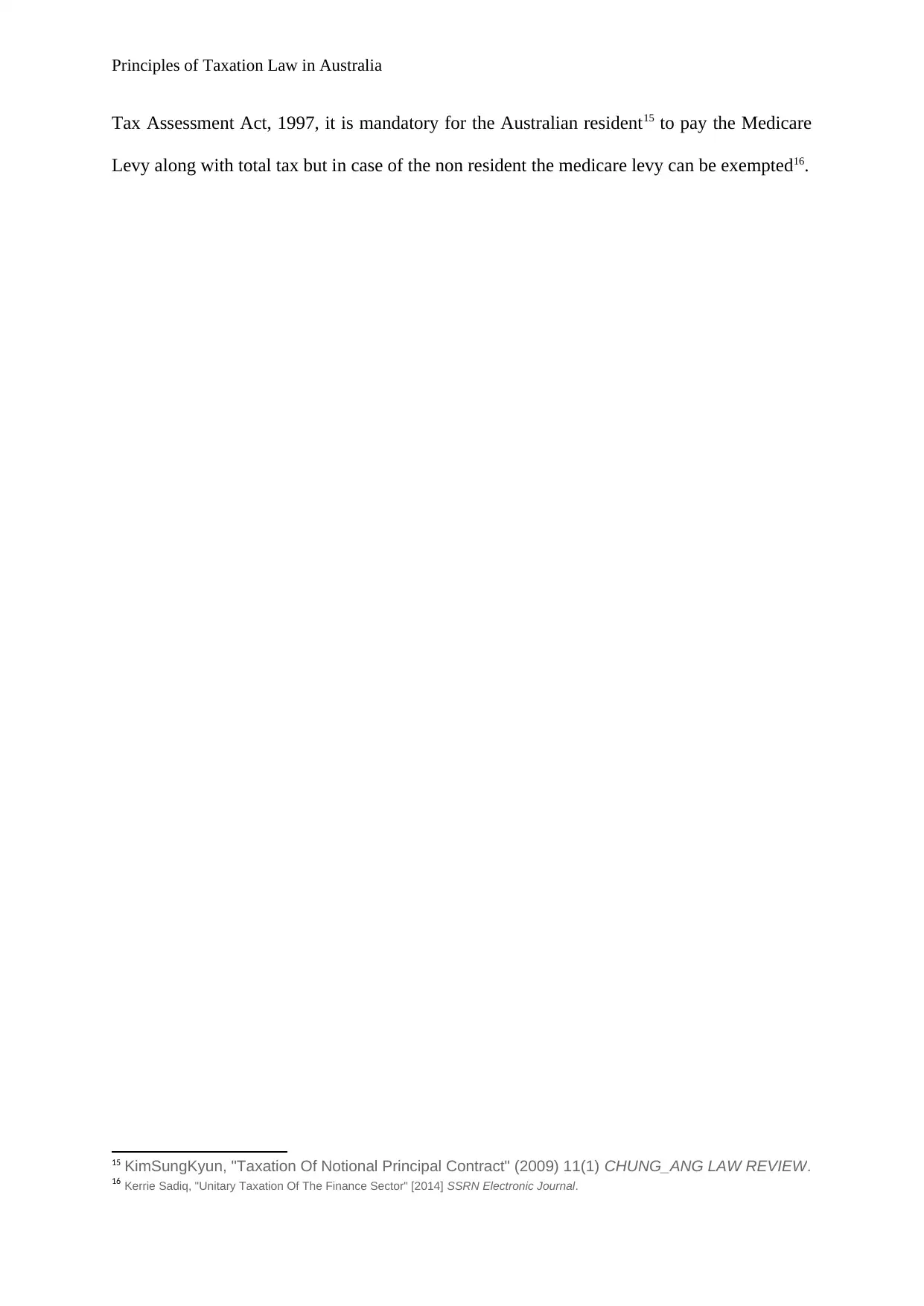
Principles of Taxation Law in Australia
Tax Assessment Act, 1997, it is mandatory for the Australian resident15 to pay the Medicare
Levy along with total tax but in case of the non resident the medicare levy can be exempted16.
15 KimSungKyun, "Taxation Of Notional Principal Contract" (2009) 11(1) CHUNG_ANG LAW REVIEW.
16 Kerrie Sadiq, "Unitary Taxation Of The Finance Sector" [2014] SSRN Electronic Journal.
Tax Assessment Act, 1997, it is mandatory for the Australian resident15 to pay the Medicare
Levy along with total tax but in case of the non resident the medicare levy can be exempted16.
15 KimSungKyun, "Taxation Of Notional Principal Contract" (2009) 11(1) CHUNG_ANG LAW REVIEW.
16 Kerrie Sadiq, "Unitary Taxation Of The Finance Sector" [2014] SSRN Electronic Journal.
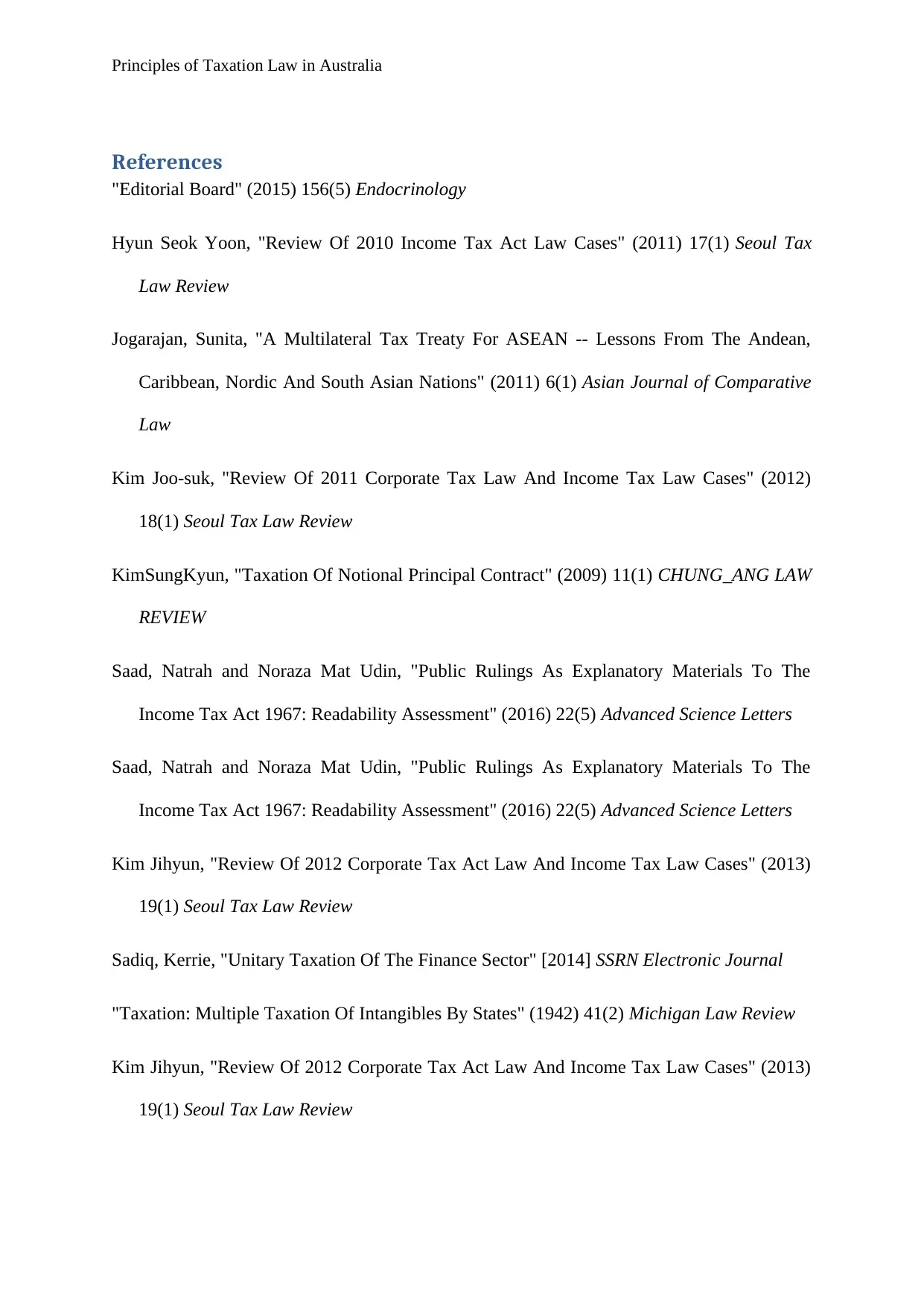
Principles of Taxation Law in Australia
References
"Editorial Board" (2015) 156(5) Endocrinology
Hyun Seok Yoon, "Review Of 2010 Income Tax Act Law Cases" (2011) 17(1) Seoul Tax
Law Review
Jogarajan, Sunita, "A Multilateral Tax Treaty For ASEAN -- Lessons From The Andean,
Caribbean, Nordic And South Asian Nations" (2011) 6(1) Asian Journal of Comparative
Law
Kim Joo-suk, "Review Of 2011 Corporate Tax Law And Income Tax Law Cases" (2012)
18(1) Seoul Tax Law Review
KimSungKyun, "Taxation Of Notional Principal Contract" (2009) 11(1) CHUNG_ANG LAW
REVIEW
Saad, Natrah and Noraza Mat Udin, "Public Rulings As Explanatory Materials To The
Income Tax Act 1967: Readability Assessment" (2016) 22(5) Advanced Science Letters
Saad, Natrah and Noraza Mat Udin, "Public Rulings As Explanatory Materials To The
Income Tax Act 1967: Readability Assessment" (2016) 22(5) Advanced Science Letters
Kim Jihyun, "Review Of 2012 Corporate Tax Act Law And Income Tax Law Cases" (2013)
19(1) Seoul Tax Law Review
Sadiq, Kerrie, "Unitary Taxation Of The Finance Sector" [2014] SSRN Electronic Journal
"Taxation: Multiple Taxation Of Intangibles By States" (1942) 41(2) Michigan Law Review
Kim Jihyun, "Review Of 2012 Corporate Tax Act Law And Income Tax Law Cases" (2013)
19(1) Seoul Tax Law Review
References
"Editorial Board" (2015) 156(5) Endocrinology
Hyun Seok Yoon, "Review Of 2010 Income Tax Act Law Cases" (2011) 17(1) Seoul Tax
Law Review
Jogarajan, Sunita, "A Multilateral Tax Treaty For ASEAN -- Lessons From The Andean,
Caribbean, Nordic And South Asian Nations" (2011) 6(1) Asian Journal of Comparative
Law
Kim Joo-suk, "Review Of 2011 Corporate Tax Law And Income Tax Law Cases" (2012)
18(1) Seoul Tax Law Review
KimSungKyun, "Taxation Of Notional Principal Contract" (2009) 11(1) CHUNG_ANG LAW
REVIEW
Saad, Natrah and Noraza Mat Udin, "Public Rulings As Explanatory Materials To The
Income Tax Act 1967: Readability Assessment" (2016) 22(5) Advanced Science Letters
Saad, Natrah and Noraza Mat Udin, "Public Rulings As Explanatory Materials To The
Income Tax Act 1967: Readability Assessment" (2016) 22(5) Advanced Science Letters
Kim Jihyun, "Review Of 2012 Corporate Tax Act Law And Income Tax Law Cases" (2013)
19(1) Seoul Tax Law Review
Sadiq, Kerrie, "Unitary Taxation Of The Finance Sector" [2014] SSRN Electronic Journal
"Taxation: Multiple Taxation Of Intangibles By States" (1942) 41(2) Michigan Law Review
Kim Jihyun, "Review Of 2012 Corporate Tax Act Law And Income Tax Law Cases" (2013)
19(1) Seoul Tax Law Review
⊘ This is a preview!⊘
Do you want full access?
Subscribe today to unlock all pages.

Trusted by 1+ million students worldwide
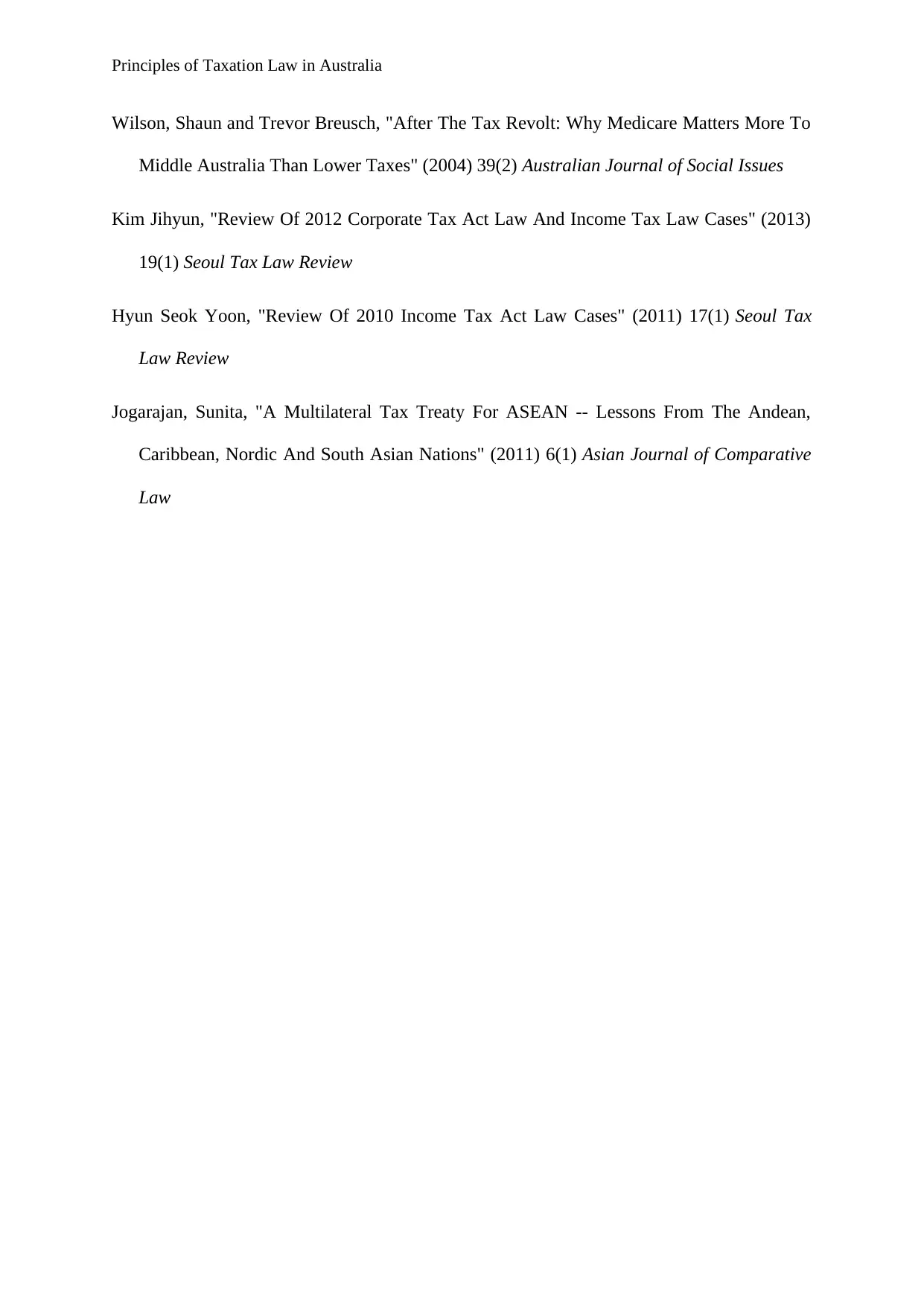
Principles of Taxation Law in Australia
Wilson, Shaun and Trevor Breusch, "After The Tax Revolt: Why Medicare Matters More To
Middle Australia Than Lower Taxes" (2004) 39(2) Australian Journal of Social Issues
Kim Jihyun, "Review Of 2012 Corporate Tax Act Law And Income Tax Law Cases" (2013)
19(1) Seoul Tax Law Review
Hyun Seok Yoon, "Review Of 2010 Income Tax Act Law Cases" (2011) 17(1) Seoul Tax
Law Review
Jogarajan, Sunita, "A Multilateral Tax Treaty For ASEAN -- Lessons From The Andean,
Caribbean, Nordic And South Asian Nations" (2011) 6(1) Asian Journal of Comparative
Law
Wilson, Shaun and Trevor Breusch, "After The Tax Revolt: Why Medicare Matters More To
Middle Australia Than Lower Taxes" (2004) 39(2) Australian Journal of Social Issues
Kim Jihyun, "Review Of 2012 Corporate Tax Act Law And Income Tax Law Cases" (2013)
19(1) Seoul Tax Law Review
Hyun Seok Yoon, "Review Of 2010 Income Tax Act Law Cases" (2011) 17(1) Seoul Tax
Law Review
Jogarajan, Sunita, "A Multilateral Tax Treaty For ASEAN -- Lessons From The Andean,
Caribbean, Nordic And South Asian Nations" (2011) 6(1) Asian Journal of Comparative
Law
1 out of 10
Related Documents
Your All-in-One AI-Powered Toolkit for Academic Success.
+13062052269
info@desklib.com
Available 24*7 on WhatsApp / Email
![[object Object]](/_next/static/media/star-bottom.7253800d.svg)
Unlock your academic potential
Copyright © 2020–2025 A2Z Services. All Rights Reserved. Developed and managed by ZUCOL.





